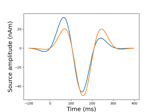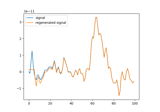mne.time_frequency.fit_iir_model_raw#
- mne.time_frequency.fit_iir_model_raw(raw, order=2, picks=None, tmin=None, tmax=None, verbose=None)[source]#
Fit an AR model to raw data and creates the corresponding IIR filter.
The computed filter is fitted to data from all of the picked channels, with frequency response given by the standard IIR formula:
\[H(e^{jw}) = \frac{1}{a[0] + a[1]e^{-jw} + ... + a[n]e^{-jnw}}\]- Parameters
- raw
Rawobject An instance of Raw.
- order
int Order of the FIR filter.
- picks
str| array_like |slice|None Channels to include. Slices and lists of integers will be interpreted as channel indices. In lists, channel type strings (e.g.,
['meg', 'eeg']) will pick channels of those types, channel name strings (e.g.,['MEG0111', 'MEG2623']will pick the given channels. Can also be the string values “all” to pick all channels, or “data” to pick data channels. None (default) will pick good data channels. Note that channels ininfo['bads']will be included if their names or indices are explicitly provided.- tmin
float The beginning of time interval in seconds.
- tmax
float The end of time interval in seconds.
- verbose
bool|str|int|None Control verbosity of the logging output. If
None, use the default verbosity level. See the logging documentation andmne.verbose()for details. Should only be passed as a keyword argument.
- raw
- Returns

